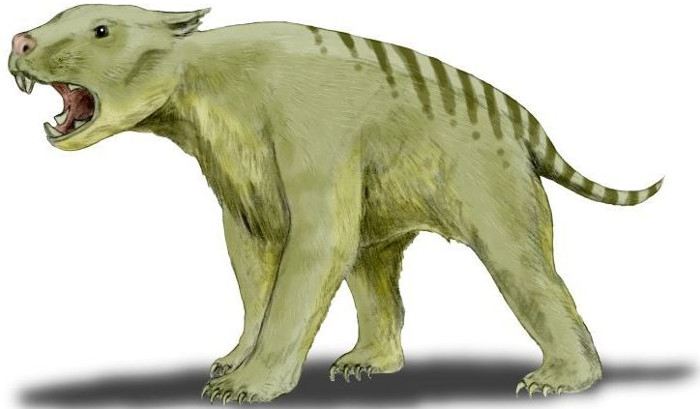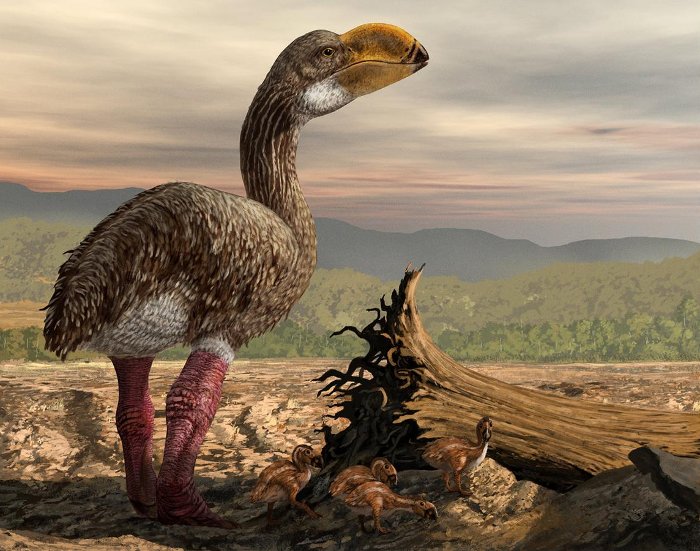Giant beasts that once dominated Australia in prehistoric times
The giant two-meter Kangaroo, a 7m-long carnivorous or lion with a bag weighing more than 100kg are among the animals that once dominated different lands in Australia tens of thousands of years ago.

According to BBC, giant bag bear Diprotodon optatum weighs over two tons and is up to 4m high in Australia from 46,000 to 1.6 million years ago.They are the largest mammal ever.Diprotodon has the same appearance as a modern rhino and has a social lifestyle like that of elephants today.Although Diprotodon is gigantic, they only eat plants.Hundreds of Diprotodon skeletons excavated at Callabonna dry salt lake in the state of South Australia show many groups of Diprotodon families who used to roam here to get food in the dry season and may be trapped in the lake when the salt lake surface is broken. .(Photo: Stocktrek Images Inc).

Giant kangaroo Procoptodon goliah lived about 15,000 years ago in Australia as the largest kangaroo known to date with a height of nearly two meters and weighs over 200 kg.Procoptodon has a large and firm thigh muscle to support body weight.In the past, they were common in semi-arid areas of New South Wales, South Australia and in open caves of the Nullarbor plain.Excessive hunting causes this kangaroo to become extinct.(Photo: Museum of Natural History).

Dominating throughout Australia in about 40,000 - 1.6 million years ago was the pocketed lion Thylacoleo carnifex , nicknamed the "strongest bite-eater".According to scientists, the bite force of a 101kg Thylacoleo is equivalent to 250kg of African lion bite.African lions take about 15 minutes to take down their prey, while Thylacoleo only takes less than a minute.The animal has a body length of nearly 1.5 meters including the tail), possessing sharp front teeth and large claws, forming the perfect weapon to defeat and rip off the prey of the prey.Fossils of bagged lions were unearthed at several locations in Australia in the middle of the 19th century. (Photo: Wikipedia).

Giant kangaroo Palorchestes azael is Australia's endemic herbivore, living about 11,000 - 11.6 million years ago. It is about the size of a horse with a body length of about 2.5 meters and a weight of about 200 kg. Large claws at Palorchestes feet are used to separate bark and make branches easier. The fossil skeletons of Palorchestes are found mainly in Naracoorte cave. Analysis of the structure of fossil bones in the nasal cavity shows that Palorchestes possesses short taps so scientists also call it "bagged tapirs".(Photo: Museum of natural history).

Coexist with giant mammals in Australia during the period of 30,000 - 8 million years ago, the flying bird Dromornis stirtoni was three meters tall and weighed 500kg.The shape of Dromornis is like a cashew species but they are close relatives of ducks and geese.Dromornis possesses a strong beak for crushing seeds.The bird's fossil fossil was found in a 55m deep well at Peak Downs in Queensland and was described in detail in 1872. (Photo: Science Photo Library).

Varanus priscus (or Megalania prisca) is the world's largest varanite , living in southern Australia and disappeared about 50,000 years ago by aboriginal aboriginal hunters.The first description of this species in 1859 indicates that it is 7m long and weighs 620kg.Like today's Komodo dragon relatives, Varanus effectively hunts because its teeth have many venom glands.Studies show that Varanus's terrestrial sprint speed is 2.6 - 3m / s.(Photo: Stocktrek Images Inc).

Australian giant turtle Meiolania platyceps is about 2.5 meters long, extinct some 2,000 - 3,000 years ago by the Lapita hunted too much.Unlike modern turtles, Meiolania has an unusual skull, two large horns developing symmetrically on the head and many spines in the tail.(Photo: Smokeybjb).

The Tasmanian tiger (also known as the Thylacinus cynocephalus wolves) has stripes of tiger-like backs and dog-like head shapes.The team led by archaeologist Stephen Wroe at the University of Sydney studied the skulls of 39 predators around the world, and confirmed that the wolf pack had three times the size of a normal dog. Equivalent weight.The Tasmanian tiger was declared extinct in 1936. The Tasmanian tiger eventually died in a zoo in Tasmania.The man who accused the Tasmanian tiger of attacking sheep from the 1800s should use all means such as hunting guns and poisons to eradicate them.(Photo: Dave Watts / naturepl.com).
- Monsters that dominated the prehistoric world
- Giant prehistoric beasts
- The largest big animals on the planet (Part 2)
- One of the most feared prehistoric beasts was extinct because of eating vegetables
- The mystery of the beast
- 3 giant prehistoric monsters can exist today
- Close up of fossils of crocodiles, elephants, giant prehistoric birds
- Ancient 'beast' version of 4 meek modern creatures
- The giant bird once dominated the Antarctic sky 50 million years ago
- The prehistoric, headless prehistoric predator
- The prehistoric insects that make you
- Earth used to have a 10-meter-long worm
 Animal 'suffering' after hibernation
Animal 'suffering' after hibernation Why do goats climb well?
Why do goats climb well? Scientists were surprised to see chimpanzees eating turtles
Scientists were surprised to see chimpanzees eating turtles Giant catfish died deadly due to drought in Thailand
Giant catfish died deadly due to drought in Thailand